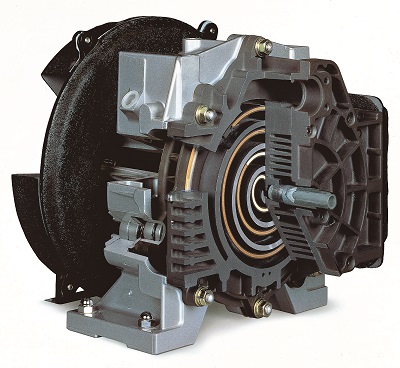Scroll compressors are positive-displacement devices that work by internal compression. Air (or other gas) is drawn in, trapped, reduced in volume and, finally, discharged at the outlet port. The concept of a scroll compressor has been around for more than a century, but it took more-recent advances in manufacturing technology to make the product viable.

The two main components are a stationary scroll and an identical moving scroll. Each is a precisely machined or cast part in the shape of an involute spiral. In a typical design, the second scroll is rotated 180° with respect to the first, which lets the scrolls mesh. They are bounded by a flat base and cover.
The moving scroll mounts on an eccentric crank offset from the center of the stationary one. The drive motor moves the scroll body in an orbital fashion about the stationary scroll, but the scroll does not rotate.
Movement creates suction that draws gas from the outer inlet openings. Gas gets trapped in crescent-shaped pockets between the two scrolls, and continuous orbiting moves it steadily toward the center, reducing volume and causing compression. Finally, it reaches the center of the assembly where pressurized gas discharges through a port.
The design of the discharge port determines the amount of internal compression, similar to that in a screw compressor. However, there are practical limits on the maximum amount of compression, mainly due to the size, shape, wall thickness and strength of the scrolls, and the size and geometry of the outlet port. Nonetheless, scroll compressors can typically generate relatively high pressures — 100 to 150 psi — in single-stage units.
For engineers, scroll compressors can offer a number of benefits. For one, the units have few moving parts. That can mean higher reliability, and they tend to have low maintenance requirements. Typical designs usually run quieter than equivalent piston compressors. Gas flow through the compressor is continuous, so this reduces the tendency for gas pulsation that can generate noise. Likewise, there are no inlet or discharge valves, and associated valve losses, that generate noise. They offer smooth and vibration-free operation, although the inherent eccentric motion of the scroll makes careful dynamic balancing essential.
Compared to reciprocating compressors, volumetric efficiency in a scroll design is aided by not having suction valves with inherent pressure losses. And while there is not complete gas exiting, as some space remains at discharge, this is not the same as the clearance volume typical of piston compressors. In a scroll compressor, final volume is never open to the compressor suction inlet. In many industrial applications, rotary screw compressors will be more efficient, but that can vary based on size and flow requirements.
They come in various designs, such as single- and two-stage units, and some offer variable-speed drives that can modulate capacity across a wide operating range. Thus, scroll compressors are quite flexible in serving application demands. For example, experts generally don’t recommend using reciprocating air compressors at a continuous 100% duty cycle; and rotary screw air compressor users normally prefer duty cycles above 50%. Scroll products work well in both low and high-duty applications.
And they can be designed to operate oil-flooded, oil-lubricated or oil-free. Oil-less versions run clean as there are no potential oil leak paths. Many so-called “oil-free” compressors have lubricated gearboxes where oil can migrate past seals and contaminate flow.
On the downside, they can be a bit pricy compared to other options. Many are advanced, premium designs that carry a higher cost — although users can mitigate that through lower energy consumption and reduced maintenance costs.
There are also size restrictions, to a certain extent. Too small and leak paths can limit size relative to discharge pressure, which makes them impractical. And at larger sizes, increasingly higher centrifugal forces acting on the moving scroll can be a detriment. Usually, for large volume demands, it is more economical for users to opt for a single large compressor, rather than teaming several smaller scroll compressors to produce sufficient flow.
Scroll compressors are widely used in the refrigeration industry and have become an important alternative to reciprocating and screw compressors for compressed air. For instance, they are quite important for generating medical and laboratory air.

Leave a Reply